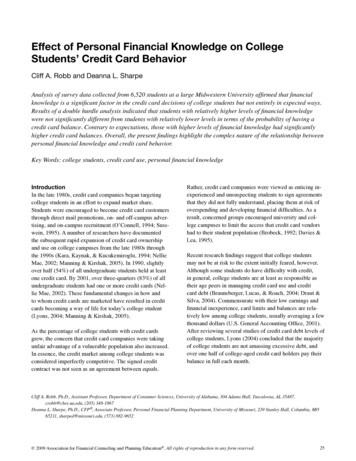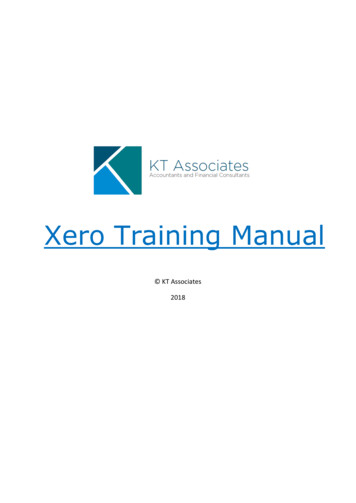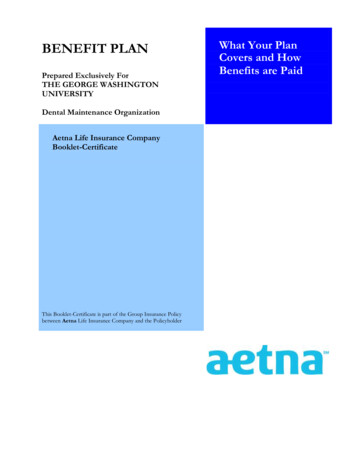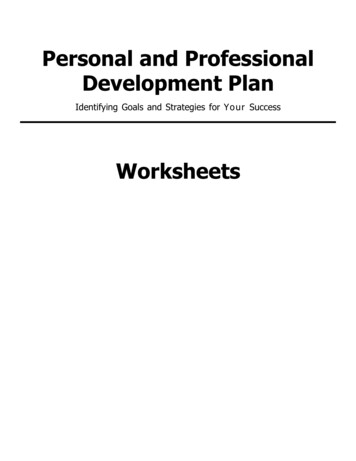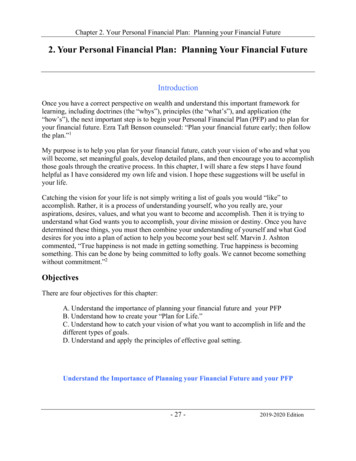
Transcription
Chapter 2. Your Personal Financial Plan: Planning your Financial Future2. Your Personal Financial Plan: Planning Your Financial FutureIntroductionOnce you have a correct perspective on wealth and understand this important framework forlearning, including doctrines (the “whys”), principles (the “what’s”), and application (the“how’s”), the next important step is to begin your Personal Financial Plan (PFP) and to plan foryour financial future. Ezra Taft Benson counseled: “Plan your financial future early; then followthe plan.”1My purpose is to help you plan for your financial future, catch your vision of who and what youwill become, set meaningful goals, develop detailed plans, and then encourage you to accomplishthose goals through the creative process. In this chapter, I will share a few steps I have foundhelpful as I have considered my own life and vision. I hope these suggestions will be useful inyour life.Catching the vision for your life is not simply writing a list of goals you would “like” toaccomplish. Rather, it is a process of understanding yourself, who you really are, youraspirations, desires, values, and what you want to become and accomplish. Then it is trying tounderstand what God wants you to accomplish, your divine mission or destiny. Once you havedetermined these things, you must then combine your understanding of yourself and what Goddesires for you into a plan of action to help you become your best self. Marvin J. Ashtoncommented, “True happiness is not made in getting something. True happiness is becomingsomething. This can be done by being committed to lofty goals. We cannot become somethingwithout commitment.”2ObjectivesThere are four objectives for this chapter:A. Understand the importance of planning your financial future and your PFPB. Understand how to create your “Plan for Life.”C. Understand how to catch your vision of what you want to accomplish in life and thedifferent types of goals.D. Understand and apply the principles of effective goal setting.Understand the Importance of Planning your Financial Future and your PFP- 27 -2019-2020 Edition
Chapter 2. Your Personal Financial Plan: Planning your Financial FutureThe purpose of financial planning is to help you plan for your financial future. What are the mostimportant things we should do in our lives? As you ponder this question, it naturally brings usback to our previous discussion, our “why’s” or doctrines of finance. They are, from an eternalperspective: Spiritual- To bring us to ChristTemporal- To help us be wiser stewardsIndividual- To help us accomplish our divine missionsFamily- To help us return with our families back to Heavenly Father’s presenceWhat are the principles or “what’s” that we should follow as we plan for our financial future?Again, they are the principles we discussed: ownership, stewardship, agency and accountability.If, as David A. Bednar states, “the answers are always in the doctrines and principles,”3shouldn’t our study begin here first as we plan for our financial future? Additionally, we havebeen counseled,Plan for your financial future. As you move through life toward retirement and thedecades which follow, we invite all . . . to plan frugally for the years following full-timeemployment. Be even more cautious . . . about “get-rich” schemes, mortgaging homes, orinvesting in uncertain ventures. Proceed cautiously so that the planning of a lifetime isnot disrupted by one or a series of poor financial decisions. Plan your financial futureearly; then follow the plan.4Ezra Taft Benson’s counsel above from nearly 30 years ago warned us against not livingfrugally, not planning for retirement, get-rich quick schemes, mortgaging homes, investing inuncertain ventures, and making poor financial decisions.So how do you plan for your financial future? You do financial planning. Its purpose is to helpyou become a wiser steward over the blessings God has blessed you with, so you can achieveyour personal mission and individual and family vision and goals. It is determining where youare, helping you catch your vision and goals of where you want to be, and helping you detailyour plans and constraints for how you will get there.Will Financial Planning help you make more money? It may not, but it will help you in yourstewardship and accountability areas to: Set your vision and goals high.Develop better plans and strategies.Be better and more informed stewards.Make wiser personal and financial choices.Make sure to get to the end of your life and you feel successful because you did thosethings that were most important.- 28 -2019-2020 Edition
Chapter 2. Your Personal Financial Plan: Planning your Financial FutureYour ultimate goal in personal finance, since it is simply part of the gospel of Jesus Christ, is toshow, with every dollar you spend, that you have chosen to take an eternal and Christianperspective rather than the world’s materialistic perspective. The sooner you realize this, thesooner and greater your motivation to obey the commandments to get your financial house morein order.Your Personal Financial Plan (PFP) is a document that accounts for all critical areas of yourpersonal financial life. It is your individual roadmap for achieving your personal and familygoals. It includes your vision, goals, tactical plans, constraints, and accountability to achievethose goals. It includes your plans for budgeting, taxes, cash management, debt reduction,insurance, investing, retirement and estate planning. It includes plans for your home and autodecision, plans to help pay for your children’s education and missions if you so choose to help.Finally, it includes your giving plan on how you will give back, to help make the world a betterplace. All of this is a critical part of Ezra Taft Benson’s admonition to “plan for your financialfuture early, and then follow the plans.”5 It requires you to catch your vision of who you are andwhat you want, determine where you are now, set goals for where you want to be, develop a planto get you there, and then creating your future with confidence by implementing and revising theplan as needed.I recommend a six-step process for creating your Personal Financial Plan:Step 1: Catch Your Vision for your LifeSomeone said, “Don’t tell me what to do, teach me who I am. Once I know who I am, I willknow what to do.”6 Do you really know who you are? Understanding who you are is critical inunderstanding and having a vision for your life. “At a training session for General Authorities,the question was asked “How can we help those struggling with [challenges in life]? ElderRussell M. Nelson stood and replied, “Teach them their identity and their purpose.”7You are more than just matter and 90% water. You are a “child of God.”8 As such, you need todecide who you are, what you want, what is important to you, and what God would have youaccomplish. These decisions express your core values and beliefs. Think through the things thatyou need to decide. What is truly important to you? What do you feel Heavenly Father wants youto do or be? What is your mission in life?Look ahead. How would you like to be remembered when you leave this life? What do you wantto accomplish with your life before you leave this earth? These are probably the most importantquestions you will ever ask and answer. If we can prepare with vision early in our lives, it will beso much easier to set those goals and plans to help us create that vision through accomplishingour personal and family goals.Step 2: Decide How You Will Evaluate Your Life- 29 -2019-2020 Edition
Chapter 2. Your Personal Financial Plan: Planning your Financial FutureDecide the criteria for how you will evaluate your life. What is truly important to you? Will it bepossessions, power, prestige, or prominence? Will it be faith, family, service and relationships?What measure will you use to determine if your life is a success? Be careful, “for where yourtreasure is, there will your heart be also.”9A good read for this section is Clayton Christensen,“How Will You Measure your Life.”10Decide what is important to you, and make that yourmeasure of success so that when you leave this life, as we all will do, you will judge your life asuccess.Step 3: Create your Plan for Life, your Personal and Family GoalsOnce you have your vision for your life, know what is important to you and where you arefinancially, it is critical to define your personal and family vision and goals. You will achievewhat you set your mind to, and you will accomplish the vision and goals that are important toyou. Think of your vision as what you want to do or become, your goals as your destination, andyour plans and strategies as what you need to do to create your vision and accomplish your goals.Once you determine your goals, write your goals down. Attach a cost to each goal. Remember,there are more costs than just financial costs. What are the true costs of your goals in terms oftime, money, and effort?It is also important to determine potential constraints or obstacles. By identifying the constraintsor obstacles early in the analysis and determining how you will avoid them, you increase yourability to plan for, avoid, and overcome those obstacles.Set a date for when your goals are to be completed. In what time frame can the goal bereasonably accomplished? Make your goals SMARTER: specific, measurable, achievable,reportable, time-bound, evaluated, and reassessed often. Then, share them with others so theymay hold you accountable for your goals.Step 4: Evaluate Your Financial HealthEvaluating your financial health helps you determine where you are financially. If you do notknow where you are, how can you determine how to get to where you need to be? To evaluateyour financial health, develop a balance sheet, an income statement, and a budget, and calculateyour financial ratios. Determine where you are financially right now – are you financiallyhealthy? Are you solvent (do you have sufficient cash in your wallet or in your checking accountto pay your bills)? How much debt do you have? How much are you saving each month andyear?Step 5: Develop Your Plans and Strategies, Constraints, and Accountability in each of the15 AreasOnce you have your vision and your goals, you must develop your tactical plans on how you willachieve those goals and when. Your plan should be:- 30 -2019-2020 Edition
Chapter 2. Your Personal Financial Plan: Planning your Financial Future Flexible—it should be able to change as your situation in life changes. Liquid—it should have the ability to convert non-cash assets into cash with relative ease andwithout excessive costs should the need arise. Protective—it should be able to meet unexpected large expenses without difficulty for theinevitable challenges that will come. Tax efficient—it should pay the government only that which is owed and not a penny more.Think long term and consider future needs. You will develop 16 separate plans for this course.Develop a Saving, Income and Expense Plan (also called a budget) and use it wisely. Plan forbig-ticket purchases, such as houses and cars/toys, and develop a plan for being wise in theseareas. Plan for managing credit and debt, and remember that debt is the enemy to growth. Decidenow what you will go into debt for and what you will not go into debt for. Plan for insurance andprotect yourself. Determine and write your Investment Plan and follow that plan on how you willinvest your assets for long-term goals. Plan for the expenses of children, including missions andeducation. Plan for retirement. Plan for how you will give back, your “giving plan.” Mostimportantly, plan your financial future early; then live your plan.Step 6: Implement Your Plan and Revise as NecessaryOnce you have your plan, implement it and begin creating. Use common sense and moderationin the things you do. Set wise goals and work toward them each day.Use wisdom in your plan, and stay positive. Remember that your plan is a goal to set your sightson, not a stick with which to beat yourself. Realize that detours will come, but stay on track afterthe detours. We all encounter detours, but good things come to those who hang in there!Revision is an important part of your plan. Remember that people and goals change—you needto account for this. Review your goals annually at a minimum, and make sure your plan stillmatches your goals. If necessary, fine-tune your plan. Remember, your plan is etched in paper,not in stone.Much of your plan is personal and challenging as you try to understand yourself, your family,and the things you want to accomplish. The purpose of this course is to help you identify criticalareas and make important decisions. In this course we will help you do Steps 1 – 4.Understand How to Catch Your Vision and the Different Types of GoalsOnce you have a correct perspective and understand the key doctrines, principles andapplication, the next step is to catch your vision. Webster’s gives four definitions for vision, “theact or power of seeing, something seen in a dream. . . that conveys a revelation, the act or powerof imagination, and something seen.”11- 31 -2019-2020 Edition
Chapter 2. Your Personal Financial Plan: Planning your Financial FutureThe scriptures teach, “Where there is no vision, the people perish.”12 Vision ranges from thesimple effort of observation to the diligent, challenging, and creative work through the power ofimagination and the Holy Ghost to thoughtfully visualize and imagine past and future events. Butis vision only for prophets? We believe having vision is for all of us.Why is vision so important? What should we have a vision of, and what will having vision allowus to do? These are important questions that should be answered, especially as vision isnecessary before we begin planning, writing, and accomplishing our personal and family goals.The scriptures encourage us to have a vision for our lives. Paul speaking of the righteousness
Chapter 2. Your Personal Financial Plan: Planning your Financial Future - 31 - 2019-2020 Edition Flexible—it should be able to change as your situation in life changes. Liquid—it should have the ability to convert non-cash assets into cash with relative ease and without excessive costs should the need arise. Protective—it should be able to meet unexpected large expenses .


